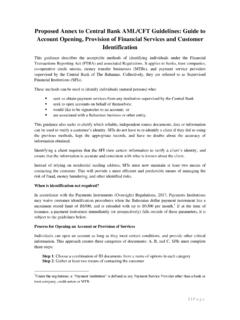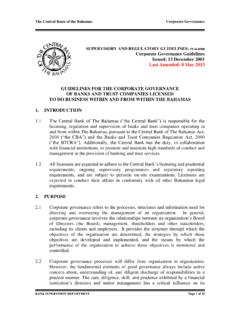Transcription of GUIDELINES FOR ELECTRONIC BANKING
1 The Central Bank of The Bahamas ELECTRONIC BANKING BANK SUPERVISION DEPARTMENT June 6, 2006 Page 1 of 11 SUPERVISORY AND REGULATORY GUIDELINES : PU23-0506 ELECTRONIC BANKING 6th June, 2006 GUIDELINES FOR ELECTRONIC BANKING I. INTRODUCTION The Central Bank of The Bahamas ( the Central Bank ) is responsible for the licensing, regulation and supervision of banks and trust companies operating in and from within The Bahamas pursuant to the Central Bank of The Bahamas Act, 2000 ( the CBA) and the Banks and Trust Companies Regulation Act, 2000 (BTCRA). Additionally, the Central Bank has the duty, in collaboration with financial institutions, to promote and maintain high standards of conduct and management in the provision of BANKING and trust services. All licensees are expected to adhere to the Central Bank s licensing and prudential requirements, ongoing supervisory programmes and regulatory reporting requirements, and are subject to periodic onsite inspections.
2 Licensees are expected to conduct their affairs in conformity with all other Bahamian legal requirements. II. PURPOSE ELECTRONIC BANKING (e- BANKING ) is defined as the automated delivery of new and traditional BANKING products and services directly to customers through ELECTRONIC , interactive communication channels. E- BANKING includes the systems that enable customers, individuals or businesses, to access accounts, transact business, or obtain information on products and services through a public or private network, including the Internet. These GUIDELINES set out the Central Bank s approach to the supervision of licensees e- BANKING services, provide licensees with guidance on general principles for risk management of e- BANKING , outline suggestions for consumer education and security, and introduce the types of internet financial services.
3 III. APPLICABILITY These GUIDELINES apply to all licensees. The Central Bank of The Bahamas ELECTRONIC BANKING BANK SUPERVISION DEPARTMENT June 6, 2006 Page 2 of 11 IV. SUPERVISORY APPROACH The Central Bank s supervisory objective is to establish and maintain a prudent regulatory regime for the provision of e- BANKING services in The Bahamas. The general principle is that licensees are expected to implement the relevant risk management controls that are commensurate with the risks associated with the types, complexity and amounts of transactions allowed (see Appendix 1) and the ELECTRONIC delivery channels adopted. The risk management controls established for e- BANKING should be fully integrated into the risk management systems of the licensee. The Central Bank endorses the principles and recommendations for e- BANKING outlined by the Basel Committee on BANKING Supervision s papers - Risk Management Principles for ELECTRONIC BANKING ( ) and the Management and Supervision of Cross-Border ELECTRONIC BANKING Activities ( ) issued July 2003.
4 Licensees are encouraged to read and understand the main principles of these documents. In keeping with a risk-based supervisory methodology, the Central Bank s supervisory framework for e- BANKING aims to provide appropriate levels of supervision of its licensees e- BANKING activities. Initial Discussions Formal approval is not required to launch new e- BANKING services or make significant changes to existing services; however as with any other potentially significant change in its operations, licensees should notify and discuss plans with the Central Bank prior to implementing such initiatives in light of the possible implications regarding operational and reputational risk, which may affect capital requirements. The Central Bank will generally require the licensee to present and discuss the strategic outlook for launching e- BANKING services, demonstrating compatibility with the overall strategy of the licensee s operations, the risk analysis for the planned project together with details of risk/reward study.
5 Importantly, management is expected to demonstrate that it has reviewed the current risk profile of its operations, considered the impact of implementing an e- BANKING service and that the board has concluded that there are no undue adverse implications for the safety and soundness of the operations given its resources, risk management systems and technical expertise. Specifically, the licensee should satisfy the Central Bank that the following issues are properly addressed:- (1) That there is proper board and senior management oversight; (2) That major technology-related controls relevant to e- BANKING have been addressed; The Central Bank of The Bahamas ELECTRONIC BANKING BANK SUPERVISION DEPARTMENT June 6, 2006 Page 3 of 11 (3) That there are appropriate security measures in place, both physical and logical together with other requisite risk management controls; (4) That any other relevant supervisory issues related to activities such as outsourcing and cross border e- BANKING activities have been addressed1; (5) That a cost-benefit analysis has been conducted of the provision of the new e- BANKING service; (6) That an e- BANKING strategy has been developed and documented.
6 The strategy should clearly outline the policies, practices and procedures that address and control all of the risks associated with e- BANKING ; (7) That the effectiveness of the plan will be monitored on an ongoing basis and that it will be updated periodically to take account of changes in technology, legal developments and the business environment including external and internal threats to information security; (8) That risks are monitored on an ongoing basis; and (9) That the board is satisfied that the licensee has the necessary level of capital vis- -vis related risks as denoted in section (V) of these GUIDELINES . Given the dynamic nature of e- BANKING and related technology, the Central Bank recognizes that the issues to be dealt with will vary with time and from one licensee to another. The preceding list, therefore, is representative of the issues that should be considered rather than being exhaustive.
7 Ongoing Supervisory Review The Central Bank will, in the course of its onsite examinations and offsite reviews, determine, as appropriate, the adequacy of the licensee s risk management of e- BANKING services based on the requirements set out in these GUIDELINES . The Central Bank may implement other monitoring processes to facilitate its ongoing supervision of e- BANKING . Licensees should promptly report any suspected or confirmed cases of fraud relating to e- BANKING , major security breaches, any material service interruption or other significant issues related to their e- BANKING services to the Central Bank. V. RISKS ASSOCIATED WITH E- BANKING ACTIVITIES ELECTRONIC BANKING creates new risk management challenges for licensees. Typically, all risks associated with traditional BANKING and products may be impacted with the 1 ( the necessary supervisory approvals from the Central Bank or overseas regulatory authority have been obtained.)
8 The Central Bank of The Bahamas ELECTRONIC BANKING BANK SUPERVISION DEPARTMENT June 6, 2006 Page 4 of 11 introduction of e- BANKING services. However, the Central Bank has identified six major categories of risk specifically associated with e- BANKING for bank supervision purposes. The risks are strategic, operational/transaction, technology, business, reputation and legal. (1) Strategic Risk is the current and prospective impact on earnings or capital arising from adverse business decisions, improper implementation of decisions, or lack of responsiveness to industry changes. Ideally, an e- BANKING service should be consistent with the bank s overall financial strategy. The planning and decision making process should focus on how specific business needs are met or enhanced by the e- BANKING product, rather than focusing on the product as an independent business objective.
9 Strategic vision should determine how the e- BANKING product is designed, implemented, and monitored. The overall strategic vision of the licensee should influence how the e- BANKING product is designed and implemented. (2) Operational/Transaction Risk arises from fraud, processing errors, system disruptions, and the inability to deliver products or services, maintain a competitive position, and manage information. In the provision of e- BANKING services, banks often rely on outsourced software companies. They require the proper management of information systems and the right capacity to service their customers. Contingency and business resumption planning is necessary for banks to be sure that they can deliver products and services in the event of adverse circumstances.
10 (3) Technology Risks are risks related to any adverse outcome, damage, loss, disruption, violation, irregularity or failure arising from the use of or reliance on computer hardware, software , ELECTRONIC devices, online networks, and telecommunications systems. These risks can also be associated with systems failures, processing errors, software defects, operating mistakes, hardware breakdowns, capacity inadequacies, network vulnerabilities, control weaknesses, security shortcomings, malicious attacks, hacking incidents, fraudulent actions and inadequate recovery capabilities. (4) Business Risk In some circumstances, due to the more savvy nature of the e- BANKING consumer, traditional BANKING risk, such as credit risks, interest rate risk, liquidity risk, and foreign exchange risk are elevated.














